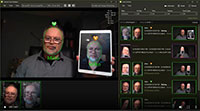
SAFR® from RealNetworks
Passive Liveness Detection
Now further hardened against spoofing, SAFR’s AI-powered liveness detection can quickly (within 0.3 seconds) and accurately (95.27% True Positive Rate) verify that a real, live person is in front of any standard RTSP or USB camera, and not a photo or video clip being presented. In version 3.4, the SAFR algorithm analyzes texture and context, based on the RGB visual spectrum field from a standard 2D camera – be it an IP camera embedded in an access control terminal, an ATM camera, or a USB or laptop camera used to authenticate the user.
Ideally suited for a broad range of applications such as touchless access control or authentication for applications like electronic wallet or online test taking, SAFR’s passive liveness detection feature is very intuitive to operate since users are not required to do anything specific such as turn their faces, look left, or right, smile, or even take off their mask if they are wearing one.
A unique feature in SAFR version 3.4 is its ability to automate alerts to security personnel when a spoofing attempt or a fraudulent attempt to gain access is detected. The new version also allows security personnel to set specific thresholds for liveness that allow them to balance end-user convenience and specific levels of liveness veracity they require, depending on use cases. With SAFR 3.4, users can view the video and liveness analysis results in real time or review event-based history records.
Compatible with any available IP camera, SAFR’s Passive Liveness Detection offers a low total cost of ownership and can be rapidly deployed on existing data and networks.
SMS Watchlist Alarms
SAFR now provides SMS alerting functionality for Windows customers and integrated out-of-the-box for Cloud customers. This represents a great solution for small to medium sized businesses that want the ability to configure SMS notifications so that staff responsible for security can be alerted, whether they are onsite or away from the office. SAFR users have the flexibility to configure SMS notifications that are triggered on a set of event conditions. Event conditions may include whether the person is a VIP or person of concern or if the individual is in a specific area.
“The new version of SAFR adds significant new levels of security for access control, whether it is authentication for physical access, or validation of a person’s identity for eKYC purposes. SAFR’s passive, AI based approach, works with 2D RGB video streams, supports BYOD based engagements and dramatically lowers the costs and complexities associated with hardware based solutions,” said Eric Hess, senior director product management at SAFR Face Recognition & Security Solutions, RealNetworks.